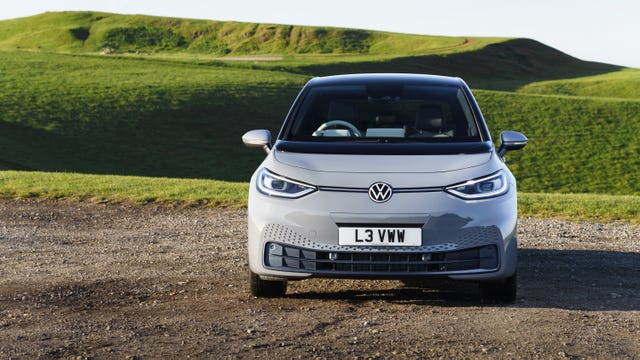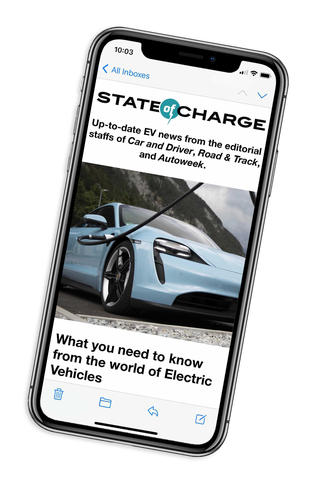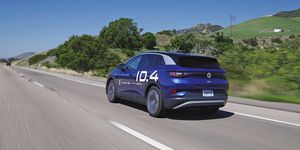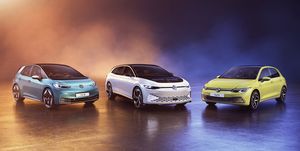The long-awaited $35,000 Tesla Model 3 may have turned out to be a niche item as Elon Musk correctly predicted, especially now that it’s not even offered anymore, with most buyers opting for better-equipped versions of the electric sedan. But another budget-priced EV is about to test the demand across the pond, as Volkswagen debuts the base version of the ID.3 hatch with a short-range battery.
The ID.3 itself has been in production for nearly a year now, beating the ID.4 to market, and it had a bit of a rough launch with some software issues that delayed deliveries. But now that the well-equipped debut versions of the ID.3 have been in production in Zwickau for some time, Volkswagen is rolling out a budget-priced version of its small electric hatch.
This particular flavor of the ID.3 is optioned with a 45-kW battery pack, giving it a range of 217 miles in the slightly optimistic WLTP cycle. This makes it the lowest-ranged model out of a lineup of ID.3 versions with 45, 58 and 77-kWh usable battery capacities. The EPA range of such a model would likely land south of 190 miles, and the single-motor hatch produces 148 hp and 229 lb-ft of torque — fairly tame figures — jogging from 0 to 62 mph in a leisurely 8.9 seconds. So it’s pretty clear what its priorities are.
This version of the ID.3 will start at £30,870 in the U.K., but will also get a fairly generous £2500 government discount, bringing its price down to £28,370, which translates to $39,100. If we were to apply the $7,500 U.S. federal discount, it’s obvious where its eventual price could be whittled down to. But this doesn’t mean it’s a bare-bones car inside.
“The model is also fitted with all-LED headlights and tail lights,” VW notes. “The ID. Light interface, meanwhile, allows the ID.3 to communicate with the driver through different light patterns corresponding with functions including navigation instructions, phone commands and battery charge status. Further enhancing the ID.3’s interior with light is 10-color ambient lighting, while natural voice control and Wireless App Connect bring additional convenience and connectivity.”
The main role of the 45-kWh ID.3, of course, is to offer a lower price to those who may not need a range above the 217-mile WLTP figure, but would still like a small electric hatch. Volkswagen has made no plans to bring the ID.3 stateside, relying on the ID.4 prior to the introduction of other electric models, and with its base price of $41,190 before any federal or local discounts it’s easy to see why the smaller hatch may not be a big seller here in short-range form. It’s certainly lower-priced than other versions of the ID.3, but it’s not giveaway-cheap like some other short-range EVs currently offered stateside.
Not only is the ID.4 already within reach, but EVs like the Nissan Leaf, Chevrolet Bolt and the Mini Cooper SE already appear to satisfy the demand for smaller EVs in the U.S. Add to that a wave of small electric SUVs and crossovers headed here this year, and the case for any version of the ID.3 begins to fade noticeably.
Of course, this is not to say that electric hatchbacks will remain a less popular choice than other electric alternatives. The decade of EVs is just getting started, and it’s too soon to tell how consumer tastes will evolve over the next several years.
VW itself isn’t planning the ID.3 to be the smallest EV in its future range, as the automaker is working on the ID.2 and the ID.1 — both expected to be smaller than the current EV hatch, and intended to play different roles. So the trend toward crossovers in various regional markets isn’t acting as a overriding factor to EV planning, as Wolfsburg is mindful of consumers who may want a car smaller than the Golf-sized ID.3. We just hope that electric hatchbacks aren’t abandoned by EV makers when it comes to the U.S., in a quest to squeeze out the most sales out of crossovers of all sizes.
Should VW offer the ID.3 or even smaller electric models stateside? Let us know in the comments below.
Source: Read Full Article





